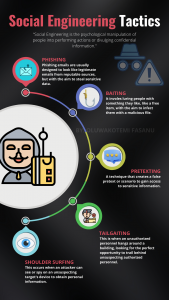Social engineering: Tactics and Prevention.
Social engineering refers to the manipulation of individuals to divulge confidential or sensitive information to cybercriminals and access or infiltrate into systems or perform other actions that may not be in their best interest. The tactics used by social engineers often involves psychological manipulation, deception, and exploitation of human emotions such as trust, fear, greed, and sympathy. Social engineering attacks can take many forms, including phishing emails, phone scams, physical impersonation, and more. This article will discuss some common examples of social engineering and suggest effective ways to prevent it.
Examples of social engineering
- Phishing scams
Phishing is one of the most common social engineering attacks. Phishing emails are usually designed to look like legitimate emails from reputable sources such as banks, social media platforms, etc. These emails can contain links to files that contains malware or fake websites that are designed to steal login credentials, credit card information, or other sensitive personal data. Phishing attacks can also be conducted via phone calls (called ‘Vishing’) or text messages (called ‘Smishing’). Example of phishing are:
- Vishing: This is when a scam artist puts a phone call through to a target, pretending to be an individual from a legitimate organization or acts as an acquaintance to get their target to release vital information which would help facilitate an attack.
- Smishing: This type of phishing scam is done via text messaging where the social engineer expresses farfetched stories or special offers to entice the target to access a malicious link or share personal information such as passwords or financial and social account details to gain unauthorized access.
- Spear phishing: Spear phishing is a targeted phishing attack that focuses on a specific individual or organization or a specific target. Attackers gather personal information about the target from various sources such as social media, company websites, or online forums, and use that information to build a highly personalized phishing email or message. The goal is to trick the target into revealing sensitive information or clicking on a malicious link.
- Baiting: Baiting is a social engineering attack that involves luring victims with something they like, such as a free USB drive, movie download, or a new iPhone. his attack uses the promise of something free to entice a user to access a malicious file or give up sensitive personal information. It could be in form of gift cards, time-sensitive promotions, or monetary compensation. The bait is usually infected with malware or other malicious code that can compromise the victim’s device or steal sensitive data.
- Pretexting: Pretexting is a technique that creates a false pretext or scenario to gain access to sensitive information. For example, an attacker may pose as a customer service provider, company manager, or IT support technician and request the victim’s login credentials or personal information.
- Pharming: Pharming is a social engineering technique that involves redirecting victims’ website traffic to another fake website by installing malicious programs without their knowledge or consent. The attacker may employ various methods such as DNS cache poisoning, links in phishing emails to redirect the victim’s traffic to a fake website that looks like a legitimate one. The goal is to steal login credentials, credit card information, or other sensitive data.
- Piggybacking: Tailgating is when an attacker hangs around a building where they do not have access rights, for the perfect opportunity to trail behind an unsuspecting individual with authorized access.

How to prevent social engineering attacks
- Be vigilant:
The first and most important step in preventing social engineering attacks is to be vigilant and skeptical. Always verify the authenticity of emails, phone calls, or messages before responding or clicking on links. Beware of suspicious unsolicited requests for personal information or login credentials.
- Use strong and secure passwords:
Use strong passwords for all your online accounts, and never use the same password for different accounts. Passwords should be long, complex, and difficult to guess.
- Enable two-factor authentication:
Two-factor authentication adds an extra layer of security to your online accounts by requesting a second form of authentication, such as a code sent to your phone, in addition to your password.
- Keep software up to date:
Keep all your software, including browsers, plugins and operating systems up to date with the latest security patches and updates. This can help prevent exploits that may be used in social engineering attacks.
- Educate employees:
Employees need to know about the risks of social engineering and how to recognize and prevent social engineering attacks. This can include training/seminars on physical security, email security, password management, and how to avoid phishing scams.
- Implement security controls:
Implementing security controls such as firewalls, intrusion detection systems, and antivirus software to help prevent social engineering attacks can help detect and block malicious traffic or suspicious behavior.
Conclusion
Social engineering attacks can be very effective because they exploit the human factor, which is often the weakest link in the security chain. Regardless of the attacker’s intentions, social engineering attacks aren’t difficult to prevent. Training seminars should be organized for employees to further improve their defense against these attacks. Important data should be kept in an archive to ensure compliance with any regulation that gives you a directive to keep electronic documentation and communication. Tools used in achieving this include various security protection measures like multifactor authentication, encryption, and user roles to manage access to sensitive information.


Recent Comments